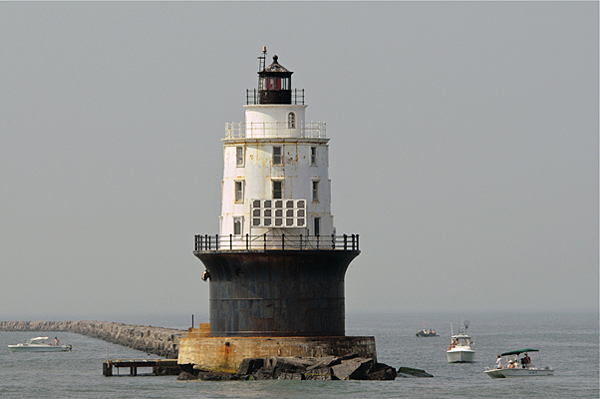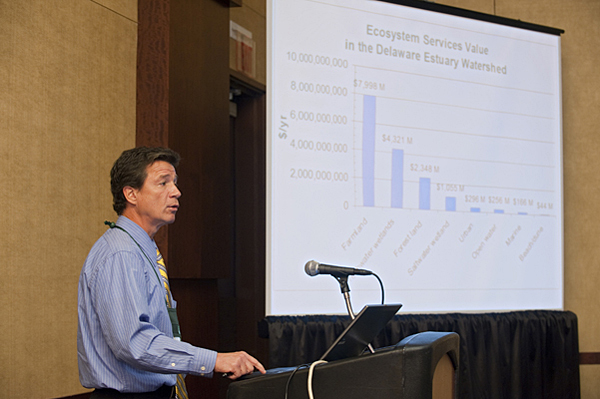Estuary is $10 billion asset
In economic drought, impact study shows Delaware Estuary is major asset
3:38 p.m., June 2, 2011--In the first economic impact study of the Delaware Estuary in 20 years, researchers from the University of Delaware’s Water Resources Agency (WRA) have found the watershed—which covers 0.2 percent of the continental U.S., yet supplies drinking water to 2 percent of the U.S. population—contributes over $10 billion annually to the region’s economy.
Calling the figure “a conservative estimate,” the researchers measured the value of the tidal Delaware River, Delaware Bay and tributaries in three different ways.
Research Stories
Chronic wounds
Prof. Heck's legacy
They found an economic impact of:
- $10 billion through economic activity from recreation, water quality and supply, hunting and fishing, forests, agriculture and parks;
- $12 billion through the value of goods and services provided by the estuary’s ecosystems (such as water filtration, flood reduction and carbon storage); and
- $10 billion through employment, including more than 500,000 direct and indirect jobs with annual wages in the coastal, farm, ecotourism, water/wastewater, recreation and port industries. This does not include federal, state and local income tax benefits, which researchers expect would have increased the economic value by one-quarter to one-third.
The three economic categories were not summed because of “overlap in values.” For example, the ecosystem values of forests for water quality benefits are partially captured in the economic value of water supply.
Nevertheless, the researchers conclude, “the estimates clearly indicate the Delaware Estuary is an economic engine that contributes over $10 billion annually to the region’s economy.”
The watershed occupies 6,000 square miles in New Jersey, Pennsylvania, Delaware and Maryland, and serves a population of more than 6.7 million. It supplies drinking water to the fifth largest metropolitan economy in the country.
“Estuary systems are economic assets,” says WRA Director Gerald Kauffman, who studies water science and policy research and holds secondary appointments in the School of Public Policy and Administration and the Department of Civil and Environmental Engineering.
“If we can improve the environment,” he says, “we can also have spin-off effects on economic redevelopment.”
While environmentalists have long touted the benefits of preserving estuaries, wetlands and other fragile environments, Kauffman’s research provides an economic incentive for their restoration.
The Delaware River Basin Conservation Act of 2011, to be introduced next month by U.S. Sen. Tom Carper (D-Del.), would authorize federal funding for the Delaware Estuary.
“It’s a cost-effective investment,” says Kauffman. “It’s worth it for the public and private sector to invest in these watersheds because it will pay off in economic impact and jobs.”
The Delaware Estuary has a long economic and ecological history—companies across the mid-Atlantic region, from DuPont to the Salem Nuclear Power Plant, depend on its waters to sustain their business. Still, there has been scant research on its economic impact. Studies from two decades ago estimated the estuary to be worth hundreds of millions, perhaps billions.
“By putting an economic value on ecology, we can show that the natural resources of the Delaware Estuary provide real and significant economic benefits to the tri-state region,” says Kauffman. “What’s more, we can show they’re worthy of investment to keep them healthy and productive.”
Kauffman is project director for the Water Resources Agency, which provides water resources planning and policy assistance to local governments. The WRA is located within the School of Public Policy Administration’s Institute for Public Administration. His research team includes associate policy scientist Andrew Homsey and public policy graduate students Sarah Chatterson, Stacey Mack and Erin McVey.
Their work was commissioned by the Partnership for the Delaware Estuary, one of just 28 tidal systems named by Congress to the U.S. Environmental Protection Agency’s National Estuary Program, and their findings are detailed in an online report, Economic Value of the Delaware Estuary Watershed.
Kauffman will also present their research at a press conference on Friday, June 3, from noon-2 p.m., on the banks of the Christina River in Wilmington. Hosted by Carper’s office, the event will promote the senator’s new bill and include remarks from the governor’s office, environmental leaders and others.
Article by Artika Rangan
Photos by Lisa Tossey and Evan Krape












